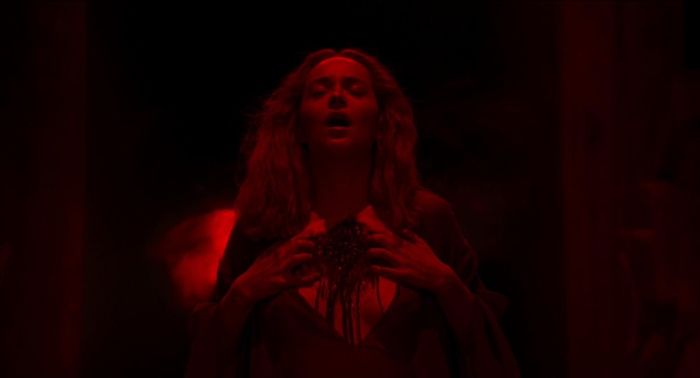Censor: a flawed but compelling dive into the nature of horror
Hannah Bowen discusses how Prano Bailey-Bond’s Censor manages to tackle horror with a fresh perspective
Content Note: This article contains discussion of violence and sexual violence.
A delightfully meta take on horror, Prano Bailey-Bond’s debut feature Censor examines what happens when the boundaries between fiction and reality become blurred. The film centres on Enid, the titular film censor, and is set in the mid-80s at the height of the media panic surrounding the proliferation of so called “video nasties”, graphically violent, low budget, straight-to-video horror flicks. The film begins with a montage of bloody clips from these tapes, voiced over by news reports concerning the controversy. Right from the start, the film’s period feel is well executed – even the logos of the production companies at the start are rendered in 80s fashion.
Early on, we learn that Enid’s sister Nina disappeared in the woods when they were both children in murky circumstances. Her parents, desperate to move on, have authorised her death certificate, which Enid struggles to accept. Notably, even as they discuss this, they avoid using Nina’s name. Niamh Algar delivers a phenomenal and nuanced performance as Enid, replete with small recurring perfectionist gestures, such as picking nervously at her fingers or stretching her back. Enid spends her days in a darkened viewing room, scrutinising films and picking scenes to cut, even sometimes opting to ban certain films entirely. Among her (mostly male) colleagues, she has a reputation for being a stickler; one colleague, the pompous George, sneeringly dubs her “Little Miss Perfect”.
“The film stretches our sympathy for Enid to breaking point, however she is still a deeply tragic figure even at her most monstrous”
Things start to go downhill at work: Enid is embroiled in a scandal surrounding a recent murder and a film she allowed to pass which featured a scene eerily similar to it, and is pursued by the press. In the midst of this, she is asked to review a disturbing, obscure horror film by its decidedly creepy and chauvinistic producer, Doug, who remarks approvingly on her appearance and offers her a role in one of his upcoming features. When Enid demurs, saying she would rather not be raped and cut up into pieces on camera, he replies “I’m sure our audience would love it”.
The film’s woodland setting bears an uncanny resemblance to Enid’s traumatic childhood memories, and, unusually for her, she is deeply shaken. She soon becomes convinced that the film holds the secret of what happened to her sister, and visits a seedy video rental to track down other releases by the director, the mysterious Frederick North, watching them alone in her flat at night. Multiple zoom-in shots of TV static immerse the viewer in Enid’s all-consuming obsession, sleeplessness, and descent into madness.
“The film is a thought-provoking meditation on how society deals with on-screen violence, and an ambivalent one at that”
Like many horror movies, Censor is a film about the agony of repression and unresolved, traumatic grief. The film stretches our sympathy for Enid to breaking point, however she is still a deeply tragic figure even at her most monstrous. Censor’s ending evokes that of another recent stand out British horror debut Saint Maud (also by a female director), with brutal and horrifying reality rupturing the protagonist’s pathological fantasy in quick, harrowing flashes. As in Saint Maud, Censor features a troubled young female protagonist in a fragile psychological state, driven to extreme actions as a result of her illness. This raises some thorny questions about the representation of mental illness in horror: while Censor is innovative in its direction and tone, especially its quasi-comedic ending, this particular trope is overused and leaves me slightly uneasy.
On another level, the film is a thought-provoking meditation on how society deals with on-screen violence, and an ambivalent one at that. On the one hand Censor seems to hint at possible links between fictional sexual violence and real-life predation (while, gratifyingly, ensuring said predators get their comeuppance), but stops short of and even actively mocks the argument that cinematic violence causes crime.
Interestingly, a stark contrast between critic and audience scores on ratings sites is already apparent, perhaps due to the slow pace of the majority of the film. In light of this, the film’s final explosive act comes somewhat out of the blue. Additionally the comic elements in the film’s ending may strike the viewer as slightly incongruous. However, for fans of horror and those interested in British social history, Censor is well worth a watch despite its flaws and I’m excited to see what Bailey-Bond has to offer us in the future.
 Comment / Plastic pubs: the problem with Cambridge alehouses 5 January 2026
Comment / Plastic pubs: the problem with Cambridge alehouses 5 January 2026 News / Cambridge businesses concerned infrastructure delays will hurt growth5 January 2026
News / Cambridge businesses concerned infrastructure delays will hurt growth5 January 2026 News / Cambridge academics stand out in King’s 2026 Honours List2 January 2026
News / Cambridge academics stand out in King’s 2026 Honours List2 January 2026 News / AstraZeneca sues for £32 million over faulty construction at Cambridge Campus31 December 2025
News / AstraZeneca sues for £32 million over faulty construction at Cambridge Campus31 December 2025 Interviews / You don’t need to peak at Cambridge, says Robin Harding31 December 2025
Interviews / You don’t need to peak at Cambridge, says Robin Harding31 December 2025










